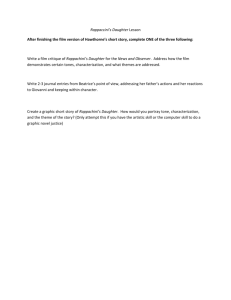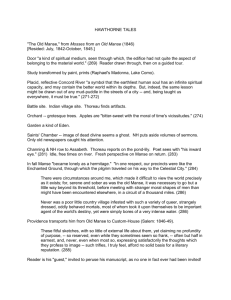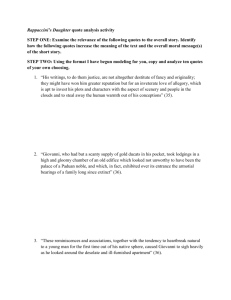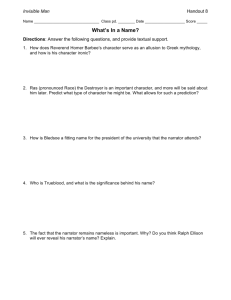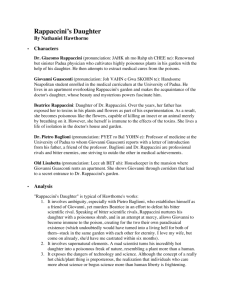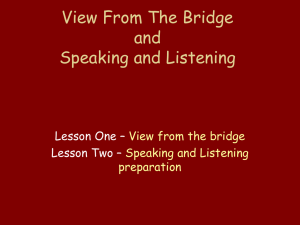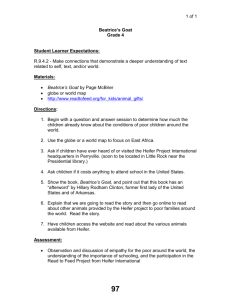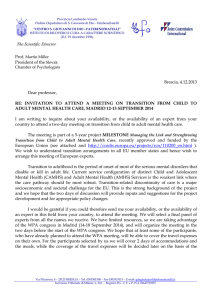The Narrator's Authority in “Rappaccini's Daughter”: The Special
advertisement
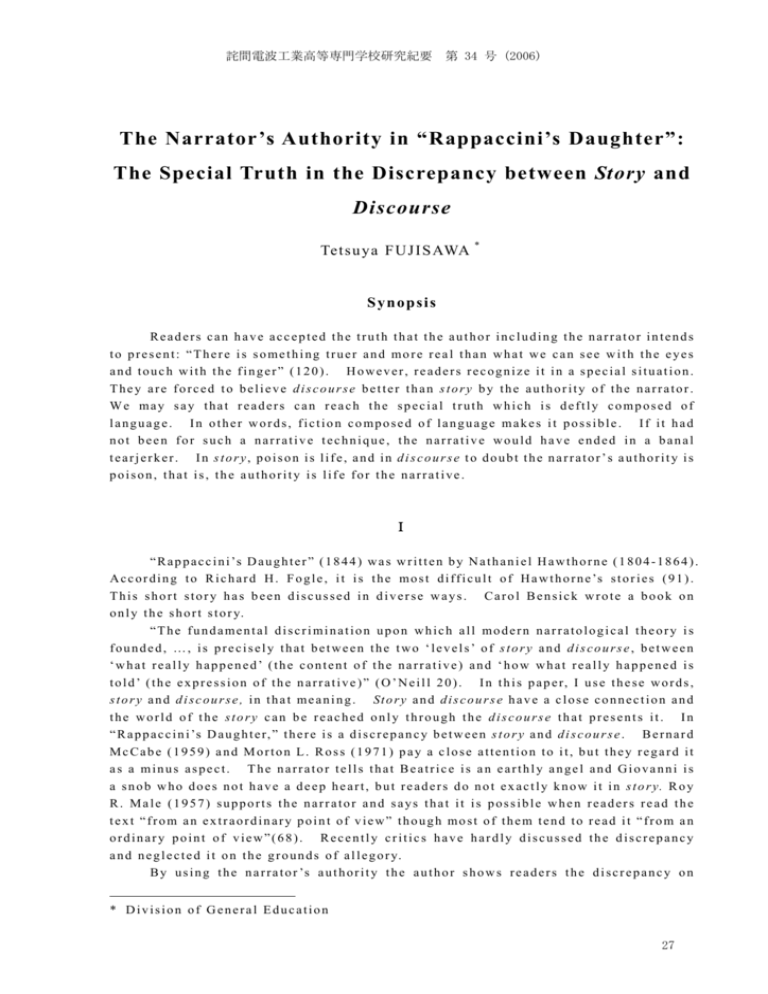
詫間電波工業高等専門学校研究紀要 第 34 号 (2006) The Narrator’s Authority in “Rappaccini’s Daughter”: The Special Truth in the Discrepancy between Story and Discourse Te t s u y a F UJ I S AWA * Sy no ps is Readers can have accepted the truth that the author including the narrator intends to present: “There is something truer and more real than what we can see with the eyes and touch with the finger” (120). However, readers recognize it in a special situation. They are forced to believe discourse better than story by the authority of the narrator. We may say that readers can reach the special truth which is deftly composed of language. In other words, fiction composed of language makes it possible. If it had not been for such a narrative technique, the narrative would have ended in a banal tearjerker. In story, poison is life, and in discourse to doubt the narrator’s authority is poison, that is, the authority is life for the narrative. Ⅰ “ R a p p a c c i n i ’s D a u g h t e r ” ( 1 8 4 4 ) w a s w r i t t e n b y N a t h a n i e l H a w t h o r n e ( 1 8 0 4 - 1 8 6 4 ) . A c c o r d i n g t o R i c h a r d H . F o g l e , i t i s t h e m o s t d i f f i c u l t o f H a w t h o r n e ’s s t o r i e s ( 9 1 ) . This short story has been discussed in diverse ways. Carol Bensick wrote a book on o n l y t h e s h o r t s t o r y. “The fundamental discrimination upon which all modern narratological theory is founded, …, is precisely that between the two ‘levels’ of story and discourse, between ‘what really happened’ (the content of the narrative) and ‘how what really happened is t o l d ’ ( t h e e x p r e s s i o n o f t h e n a r r a t i v e ) ” ( O ’ N e i l l 2 0 ) . I n t h i s p a p e r, I u s e t h e s e w o r d s , s t o r y a n d d i s c o u r s e , i n t h a t m e a n i n g . St o r y a n d d i s c o u r s e h a v e a c l o s e c o n n e c t i o n a n d the world of the story can be reached only through the discourse that presents it. In “ R a p p a c c i n i ’s D a u g h t e r, ” t h e r e i s a d i s c r e p a n c y b e t w e e n s t o r y a n d d i s c o u r s e . B e r n a r d McCabe (1959) and Morton L. Ross (1971) pay a close attention to it, but they regard it as a minus aspect. The narrator tells that Beatrice is an earthly angel and Giovanni is a s n o b w h o d o e s n o t h a v e a d e e p h e a r t , b u t r e a d e r s d o n o t e x a c t l y k n o w i t i n s t o r y. R o y R. Male (1957) supports the narrator and says that it is possible when readers read the text “from an extraordinary point of view” though most of them tend to read it “from an ordinary point of view”(68). Recently critics have hardly discussed the discrepancy a n d n e g l e c t e d i t o n t h e g r o u n d s o f a l l e g o r y. B y u s i n g t h e n a r r a t o r ’s a u t h o r i t y t h e a u t h o r s h o w s r e a d e r s t h e d i s c r e p a n c y o n * Division of General Education 27 THE BULLETIN OF TAKUMA NATIONAL COLLEGE OF TECHNOLOGY No.34 (2006) purpose so that readers know the narrative is fiction which is composed of language, a n d t h e n m a k e t h e m b e l i e v e d i s c o u r s e . T h e a u t h o r ’s i n t e n t i o n i n c l u d i n g t h e n a r r a t o r i s to show that “[t]here is something truer and more real than what we can see with the eyes and touch with the finger” (120). What I wish to discuss in this paper is that the intention, that is, truth is achieved, showing the narrative is fiction. Ⅱ As for whether or not Beatrice is poisonous, it is the narrator that makes it a m b i g u o u s . T h e n a r r a t o r c h o o s e s G i o v a n n i a s a r e f l e c t o r, a n d t h e r e a d e r i s i n v o l v e d i n G i o v a n n i ’s i m p e r f e c t a n d l i m i t e d p o i n t o f v i e w. I n t h e f i r s t G i o v a n n i ’ s o b s e r v a t i o n o f the garden from the high window, he clearly observes that Beatrice handles and inhales the odor of several of the plants which Rappaccini sedulously avoided with a pair of thick gloves and a mask. Rappaccini even tells her why he avoids the plants: “Yet, shattered as I am, my life might pay the penalty of approaching it so closely as circumstances demand” (97). On the other hand, the narrator repeatedly questions the r e l i a b i l i t y o f h i s s e n s e s , a n d t e l l s t h a t “ e r r o r s o f f a n c y, o r e v e n o f j u d g m e n t ” ( 9 8 ) b r i n g about it. Giovanni seems that he cannot believe what he saw and felt of a sudden, but the narrator criticizes him for taking “a most rational view of the whole matter” (98). A f t e r G i o v a n n i c o m e s t o h i s r o o m f r o m B a g l i o n i ’s h o u s e , h e l o o k s d o w n a t t h e garden again. The narrator intrudes into the text and makes it ambiguous so that readers can be confused. The narrator first questions the authenticity of what G i o v a n n i w i l l o b s e r v e : “ B u t n o w, u n l e s s G i o v a n n i ' s d r a u g h t s o f w i n e h a d b e w i l d e r e d his senses, a singular incident occurred (102). As for a small reptile, Giovanni thinks t h a t i t d i e d a n d t h e n a r r a t o r d e n i e s i t . YA H A G I S a n z o d e s c r i b e s i t a s “ m u l t i p l e p o i n t s of view” (2). It appeared to Giovanni - but, at the distance from which he gazed, he could scarcely have seen anything so minute - it appeared to him, however, that a drop or two of moisture from the broken stem of the flower descended upon the lizard's head. (102-3) Which points of view should readers believe? While readers are confused, the narrator adds: “Beatrice observed this remarkable phenomenon and crossed herself, sadly, but without surprise; nor did she therefore hesitate to arrange the fatal flower in her b o s o m ” ( 1 0 3 I t a l i c s m i n e ) . A t l e a s t G i o v a n n i s e e s B e a t r i c e ’s a c t i o n , b u t w h o j u d g e s the flower to be “fatal”? When it is Giovanni, the narrator’s comments might be rejected. When it is the narrator, the point of view belongs to Giovanni and the voice to the narrator. Since readers cannot decide it, they are confused more and more. N e x t G i o v a n n i o b s e r v e s t h a t a b u t t e r f l y f a l l s a n d d i e s a t B e a t r i c e ’s f e e t . T h e n a r r a t o r first intrudes saying, “Now, here it could not be but that Giovanni Guasconti's eyes deceived him” (103). Moreover, the narrator tells Giovanni fancies it. However, the narrator suggests that what he saw is correct “from no cause that he could discern, unless it were the atmosphere of her breath” (103). Both Giovanni and Beatrice clearly assume that the reptile and the butterfly are dead. Readers probably do not doubt that the flower and Beatrice give birth to it. Therefore, 28 詫間電波工業高等専門学校研究紀要 第 34 号 (2006) r e a d e r s t a k e c a r e f u l a t t e n t i o n n o t s o m u c h t o G i o v a n n i ’s r e l i a b i l i t y a s t o t h e n a r r a t o r ( ’s authority). When Giovanni sees Beatrice with the fatal flower in her bosom, he trembles, and at the same time, says, “Am I awake? Have I my sense?” (103). In fact, Giovanni implicitly trusts what he saw as well as readers, but it was so odd that he just cannot make the final determination. It can be also explained by the bouquet Giovanni bought. Judging from his dream of the previous night, he supposes in the back of his mind that Beatrice and some flowers in the garden are “fraught with some strange p e r i l ” ( 9 8 ) . M o r e o v e r, h e s m e l l s t h e f l o w e r s ’ o d o r i n h i s r o o m . T h e r e f o r e , o n h i s w a y t o h i s c h a m b e r f r o m B a g l i o n i ’s h o u s e , G i o v a n n i , w i t h s t r a n g e f a n t a s i e s i n r e f e r e n c e t o Rappaccini and Beatrice, buys a fresh bouquet of flowers. Maybe he purchases them to see whether or not the flowers are fresh in his room. “Scarcely knowing what he did”(104), Giovanni throws down the flowers. He unconsciously does it so that he can s e e w h e t h e r o r n o t t h e y a r e f r e s h i n B e a t r i c e ’s h a n d ; “ i t s e e m e d t o G i o v a n n i , w h e n s h e was on the point of vanishing beneath the sculptured portal, that his beautiful bouquet was already beginning to wither in her grasp”(104). As Carol Bensick points out, “[t]he ‘already’ clearly indicates that Giovanni was expecting something to happen to the bouquet”(3). As for the withered bouquet, “there could be no possibility of distinguishing a faded flower from a fresh one at so great a distance” (104). The narrator again denies what Giovanni saw. In the end, when it is certain that Beatrice and some plants in the garden, including Giovanni, have poison, what he saw turns out to be correct. The narrator makes readers confused by his authority and even shows it to us. In other words, the narrator shows that the narrative is the very fiction created by it. In this point, readers are conscious of the discrepancy between story and discourse and seem to believe the latter better. Ⅲ Before Giovanni actually meets Beatrice in the garden, he makes the lurid i n t e r m i x t u r e o f l o v e a n d h o r r o r i n h i s m i n d , b u t i t a l t e r n a t e l y v a n q u i s h e s o n e a n o t h e r. A s Ya h a g i p o i n t s o u t , i t m e a n s e i t h e r l o v e o v e r c o m e s h o r r o r o r h o r r o r d e f e a t s l o v e , a n d neither of them appears as a mixture (8). Giovanni is almost conscious that Beatrice is p o i s o n o u s , b u t h e t h i n k s s h e i s b e a u t i f u l a n d w a n t s t o a s s o c i a t e w i t h h e r. I f h e h a d n o t b e e n i n t e r e s t e d i n h e r, h e w o u l d h a v e e s c a p e d f r o m h e r a n d g o n e o u t o f P a d u a j u s t l i k e the narrator advises. Who reproaches Giovanni now? H o w e v e r, t h e n a r r a t o r b e g i n s to do it: “Giovanni had not a deep heart” (105), and, at the same time, begins to affirms that Beatrice is poisonous: “he had at least instilled a fierce and subtle poison into his system” (105). After Giovanni meets Beatrice in the garden, he keeps what he does not want to see in the back of my mind. Giovanni regards Beatrice as the being “whom he had idealized in such hues of terror - in whom he had positively witnessed such manifestations of dreadful attributes.” “But such reflections were only momentary; the effect of her character was too real, not to make itself familiar at once.” (113). As for her character, he idealizes and, by a faintness caused by Beatrice's breath, “he seemed to gaze through the beautiful girl's eyes into her transparent soul, and felt no more doubt or fear”(112). Some critics interpret the poison as sexuality. It is true 29 THE BULLETIN OF TAKUMA NATIONAL COLLEGE OF TECHNOLOGY No.34 (2006) we may say his sexuality is one of the reasons why he idealizes her, but to argue s y m b o l i s m o f p o i s o n w o u l d c a r r y u s t o f a r a w a y f r o m t h e p u r p o s e o f t h i s p a p e r. A n y w a y, h e r e f u s e s t o a c k n o w l e d g e t h e h u e s o f t e r r o r a n d d r e a d f u l t e r r o r. The painful purple prints of Beatrice’s finger absolutely terminate an argument about Beatrice’s poison: Both Giovanni and readers make no doubt about her poison. G i o v a n n i t r i e s t o d i r e c t h i s a t t e n t i o n t o B e a t r i c e ’s g o o d p o i n t s , n o t t o b a d o n e s . T h o u g h h e w a v e r e d i n h i s d e t e r m i n a t i o n o f h o p e o r f e a r, h e h a s s e l e c t e d h o p e o v e r f e a r. At this point, it is not far from the truth to say that Giovanni is trying to love Beatrice, o v e r c o m i n g h i s f e a r. H o w e v e r, i t i s t h e n a r r a t o r t h a t d e c i d e s t h a t h e d o e s n o t a d e e p heart and has foretold that the love will die. Oh, how stubbornly does love - or even that cunning semblance of love which flourishes in the imagination, but strikes no depth of root into the heart - how stubbornly does it hold its faith until the moment comes when it is doomed to vanish into thin mist! (115) The reasons why the narrator blames Giovanni are as follows: Those tokens, which he had hitherto considered as proofs of a frightful peculiarity in her physical and moral system were now either forgotten, or, by the subtle sophistry of passion transmitted into a golden crown of enchantment, rendering Beatrice the more admirable, by so much as she was the more unique. Whatever had looked ugly, was now beautiful; or, if incapable of such a change, it stole away and hid itself among those shapeless half ideas, which throng the dim region beyond the daylight of our perfect consciousness. (114) The narrator does not tell the reasons clearly but points out two possibilities: Giovanni has forgotten or distorted Beatrice’s frightful peculiarity. The narrator almost abuses Giovanni. Even if it is the device of multiple-choice, there are no differences in that the narrator just criticizes him. The narrator tells the reasons why Giovanni’s love is “cunning semblance” or “a revery,” but does not concretely show them, though he tries not to face her minus aspects in order to see her plus ones. If Beatrice just had had a poison and Giovanni had not had it, he might have kept loving her. If Giovanni had not been temped by Baglioni, he might not have put her to the test. On the other hand, since the narrator tells about Beatrice from Giovanni’s point of view, readers never see her minus aspects. Moreover, the narrator builds up a good image of Beatrice through free indirect speech: “She was human: her nature was endowed with all gentle and feminine qualities; she was worthiest to be worshipped; she was capable, surely, on her part, of the height and heroism of love” (114). For the impression of Giovanni in the first meeting with Beatrice, it seems to be extreme. Free indirect speech is the way to simultaneously show points of view of both the narrator and a character and to blur the border between them. That is to say, the narrator intrudes into the character’s inner and tells it from the point of view, and the two points of view are combined (Maeda, 151). We hear the narrator’s voice under the disguise of Giovanni’s point of view. The play within a play told by Baglioni causes Giovanni to begin to think about 30 詫間電波工業高等専門学校研究紀要 第 34 号 (2006) B e a t r i c e ’s p o i s o n a g a i n w h i c h e x i s t e d w i t h i n h i s u n c o n s c i o u s : “ H e r p o i s o n h a s n o t y e t i n s i n u a t e d i t s e l f i n t o m y s y s t e m ” ( 1 2 1 ) , a n d t o d i s t r u s t h e r. A t t h e s a m e t i m e , t h e narrator becomes omniscient and, using about one page, explains what has happened in order to declare that Giovanni is wrong and Beatrice is true: He actually does not love h e r, b u t “ t h e p u r e l i g h t o f h e r c h a r a c t e r ” o r “ t h e n e c e s s a r y f o r c e o f h e r h i g h a t t r i b u t e s ” ( 1 2 0 ) m a k e G i o v a n n i c h e r i s h t h e d e l u s i o n t h a t h e l o v e s h e r, a n d “ h e f e l l d o w n , grovelling among earthly doubts, and defiled therewith the pure whiteness of Beatrice's image” (120). As Bensick supposes, “this resort to moral judgment seems unsatisfactory. ... Supposing Giovanni is unutterably shallow, we still need to know what activates his shallowness (10). Beatrice only prevents Giovanni from touching a poisonous shrub. As Ross points out, “the narrator by fiat has simply instead that a preoccupation with Beatrice’s lethal exterior must give way to knowledge that the real Beatrice is angel” (343). We are now in a position to say the narrator’s scheme is obvious. The narrator would like to assert that “[t]here is something truer and more real than what we can see with the eyes and touch with the finger” (120). It is the narrator’s intention to show for a moral: Giovanni, without having a deep heart, is never able to know that Beatrice is an earthly angel. However, neither Giovanni nor Beatrice, as we have seen, gives readers the reason, nor does narrator tell any evidence to judge it. Here, we could be aware of a discrepancy between story and discourse, but most of us could not. Fundamentally, readers have to believe what an omniscient narrator says. To borrow Allan Gardner Lloyd Smith’s phrase, the narrator asserts unequivocally that Beatrice is an angel and readers’ earthly doubts amount to a defilement of the pure whiteness of Beatrice’s image like Rappaccini’s poisonous intrusion (38). Especially in the main intention of the narrator, doubting an omniscient narrator can be compared to poison. Therefore, readers should not doubt what Giovanni has no deep heart. We may say that the frequent and radial intrusions of the narrator can be compared to an antidote to readers so that they cannot doubt the narrator. Ⅳ T h e n a r r a t o r, a s w e h a v e s e e n b e f o r e , l a b e l s t h e c h a r a c t e r s , m a k i n g t h e m o s t o f his authority just like Giovanni is a snob and Beatrice is an angel. Baglioni is no exception, but he differs from other characters in that he tries to overturn it. The n a r r a t o r a l l o t s l o s e r ’s r o l e t o h i m , a n d d i r e c t l y s h o w s i t t o t h e r e a d e r. The youth [Giovanni] might have taken Baglioni's opinions with many grains of allowance, had he known that there was a professional warfare of long continuance between him and Dr. Rappaccini, in which the latter was generally thought to have gained the advantage. If the reader be inclined to judge for himself, we refer him to certain black-letter tracts on both sides, preserved in the medical department of the University of Padua. (100) B a g l i o n i r e c k o n s R a p p a c c i n i a s a r i v a l , b u t t h e f o r m e r i s m u c h i n f e r i o r t o t h e l a t t e r. Therefore, even if Baglioni condemns Rappaccini for his immoral attitude toward medical science, he is deemed to cry sour grapes. Since Baglioni is well aware of his 31 THE BULLETIN OF TAKUMA NATIONAL COLLEGE OF TECHNOLOGY No.34 (2006) sense of inferiority to Rappaccini, he reaches a decision to “foil”(108) and “thwart” ( 11 9 ) h i m . H e w o u l d l i k e t o g a i n s u p e r i o r i t y o v e r R a p p a c c i n i . B a g l i o n i ’s s t o r y w i t h i n a s t o r y i s v e r y i m p o r t a n t w h e n w e t h i n k a b o u t f i c t i o n . Before turning to discussion about it, we must draw close attention to Baglioni himself b e c a u s e i t r e f l e c t s h i s s u b j e c t a s s u m p t i o n s o r r u m o r. We m a y s a y t h a t h e i s a n u n r e l i a b l e n a r r a t o r. B a g l i o n i t h i n k s o f t h e r u m o r a b o u t R a p p a c c i n i a s b e i n g t r u e because he knows him very well. Rappaccini “cares infinitely more for science than for mankind. His patients are interesting to him only as subjects for some new experiment” (99). According to the rumor, “[h]e would sacrifice human life, his own among the rest, or whatever else was dearest to him” (99), but Baglioni believes that he must sacrifice human life for his experiment. When Baglioni first met Giovanni, he described Rappaccini as “a man who might hereafter chance to hold your [Giovanni’s] life and death in his hands” (99). A little later, Baglioni tells Giovanni that Rappaccini’s instances of success are “the work of chance” and his failures “may justly be considered his won work” (100). Baglioni assumes that Giovanni can die when he becomes the subject of Rappaccini’s experiment. Regarding Beatrice, Baglioni believes the rumor that Rappaccini instructed her deeply in his science and she is already qualified to fill a professor’s chair. The rumor, which turns out to be wrong, makes Baglioni assume that Rappaccini destines Beatrice for Baglioni’s chair. Baglioni seems to worry about it, and he casts a spotlight on her beyond necessity. As soon as Baglioni infers that Rappaccini has a scientific interest in Giovanni, he assumes that Beatrice plays a part in her father’s experiment and decides to pay close attention to her. However, he actually has no means to know her very well, and he hits on an idea as to her and his father’s experiment when he happens to read a classical literature. He does not mind embracing his opinion on the base on rumor and fiction. Let us now return to the story within a story. Thomas Browne’s Vulgar Errors (1646) seems to be the probable source for it (Notes in Norton 204), but there is no fatale breath which has poison and the poisonous girl is not an angel in it (Matsusaka 148,49). Therefore, readers do not have the exact source. On the other hand, since Baglioni said to Giovanni, “Possibly you may remember it” (117), the story exists for the characters. [A]n Indian prince …sent a beautiful woman as a present to Alexander the Great. She was as lovely as the dawn, and gorgeous as the sunset; but what especially distinguished her was a certain rich perfume in her breath…. Alexander…fell in love at first sight with this magnificent stranger; but …[she] had been nourished with poisons from her birth upward, until her whole nature was so imbued with them, that she herself had become the deadliest poison in existence. Poison was her element of life. With that rich perfume of her breath she blasted the very air. (117) Baglioni just chooses this story because there is a poisonous woman and a sage physician who discovers the secret. It is clear that he identifies himself with the physician. Baglioni only has the information that Rappaccini can sacrifice anybody including himself and his daughter, and he also knows about poison very well. It 32 詫間電波工業高等専門学校研究紀要 第 34 号 (2006) seems reasonable to suppose that Baglioni concludes that Rappaccini made her daughter poisonous. Other than that, he cannot presume anything. If he had probed the relationship between Beatrice and some plants in the garden, he could have hit on something when he smelled singular fragrance like the breath of a flower in Giovanni’s apartment. As for Beatrice’s breath, Baglioni mere adapts the Indian woman’s breath with hers without reasonable ground. Probably he speculated that poisonous Beatrice as well as the Indian woman could expel fatal breath. Baglioni said that “[t]hat old fable of the Indian woman has become a truth by the deep and deadly science of Rappaccini and in the person of the lovely Beatrice” (118-19), but in that point, it did not hold true. It is in Giovanni’s mind that the story within a story becomes almost true. Fiction brought by Baglioni has a great influence on another character. The story within a story has little in common with the story of Rappaccini and Beatrice. Baglioni just would like to tell Giovanni that Beatrice is poisonous so that Giovanni will have her drink the antidote, because it enables him to thwart Rappaccini’s experiment. In fact, Beatrice does not make positive efforts to die Giovanni by her breath, and the breath can die insects, but cannot die man. The aim in Rappaccini’s experiment is not to kill Giovanni but to make him poisonous as well as Beatrice. Baglioni alludes to the possibility of Giovanni’s death, but he does not directly associate it with the story within a story: “Perhaps the result is to be death - perhaps a fate more awful still [because] Rappaccini, with what he calls the interest of science before his eyes, will hesitate at nothing” (119). The Indian woman who was sent to kill the enemy seems to tick in his head. Hardly had Giovanni heard the story within a story when he was sure Beatrice was poisonous. However, by the time he knows he himself has been poisonous, he tries to keep loving her. The reason for it is that he tries to perform some decisive test though he cannot help expecting a bad result. “Not that he gave her up; he did but distrust” (120), we may say that he makes an extravagant effort to love Beatrice. Just after Giovanni knows he is poisonous as well as Beatrice, Baglioni’s story within a story has a great influence on Giovanni. He starts to believe that the breath of Beatrice and himself can kill man. He asserts that Beatrice is the only being whom his breath may not slay or that if they dip their fingers in the holy water in church people who come after them will perish. Someone would have been killed in the Florist shop where Giovanni went to buy a bouquet for his last decisive test. However, Giovanni believes that his breath can kill anybody except Beatrice and that he is isolated from all the warmth of life. As I have said before, had he known that he could live outside the garden, he would not have vehemently criticized Beatrice. Although fuller discussion will be presented later, she was vaguely aware that meeting with him in the garden made him poisonous, and she would not like to meet Giovanni viciously just like the Indian woman. Then, what made Giovanni poisonous? Is it Beatrice’s breath or the plants in the garden? There is no apparent cause for it, but Giovanni assumes that he has become poisonous on account of Beatrice: “Thou [Beatrice] hast made me as hateful, as ugly, as loathsome and deadly a creature as thyself” (124). Giovanni believes that Beatrice made him a loathsome and deadly creature on purpose. If he had not done that, he would not been abusive to her. If he had not heard Baglioni’s story within a story, which is fiction, he would not have hurt her feelings so much. 33 THE BULLETIN OF TAKUMA NATIONAL COLLEGE OF TECHNOLOGY No.34 (2006) Ⅴ The story within a story makes Giovanni curse Beatrice and by it she and he turn out to be two of a kind. That is to say, she recognizes that her poison can infect him but she seals it deep in the recess of her mind because she wants to be loved. As soon as Beatrice sees that Giovanni’s breath kills some insects, she shrieks, “It is my father’s fatal science! No, no, Giovanni; it was not I!”(125). As Frederick Crews points out, “This self-justification appears to rest on the scarcely believable fact that Beatrice ... has never once considered that he might be taking contagion from her” (119-20). Beatrice shifts the responsibility onto her father without a pause in order to have self-justification. One can safely state that it is one of the evidences that she is aware of the possibility of the infection. Just after it, as Beatrice continues that “my father! – he has united us in this fearful sympathy” (125), she perceives Rappaccini’s intension. It is clear that she understands that meeting with him in the garden makes him poisonous some day but she has hoarded it in the back of her mind. Let us look at the scenes where Beatrice tries to hide the fact that she is poisonous and seems to grasp meeting with Giovanni made him poisonous. In the first meeting with Giovanni, Beatrice at first tells him to believe nothing of her except what he sees with his own eyes. Giovanni, who recollects the dead a reptile, a butterfly and withered flowers, asks her to bid him believe nothing except what comes from her own lips, and she understands what he has thought. She gets red in the face, but bids him responding to his gaze of uneasy suspicion with a queenlike haughtiness. She behaves as if she had a joke with him, and she is trying to quell his doubts. Moreover, Beatrice urges him not to believe what he saw in the garden: “Forget whatever you may have fancied in regard to me. If true to the outward senses, still it may be false in its essence” (112). In this scene, Beatrice not only disguises herself but also takes a measure so that he will not pry into it. After that, when Giovanni is about to pluck a toxic shrub, Beatrice stops him from doing it and flees from him hiding her face. If just the shrub had been dangerous, she would not have hinder him uttering a shriek that went through his heart like a dagger and would not flown away from him. It is true she probably got panicky because she suddenly faced she was poisonous as well as the shrub, but it had been enough for her to warn him not to touch it. It seems reasonable to suppose that Beatrice grasps the possibility that getting alone with him can make him poisonous. Beatrice and Giovanni meet each other again hoarding what they do not want to consider in the back their mind. The continual meeting with Beatrice in the garden was “the whole space in which he might be said to love; .... Nor was it otherwise with the daughter of Rappaccini”(115). Who blames them for it? Neither does even the narrator in this scene: “After the first interview, a second was in the inevitable course of what we call fate” (115). As we have seen, however, the narrator reproaches only Giovanni with his cunning semblance of love though he tries to love her by forgetting her poison. After the first interview, Beatrice must have suffered deep conflict over whether to meet Giovanni again. There are no differences between them except the narrator keeps blaming Giovanni. Readers cannot know what Beatrice thinks or worry about because the narrator adopts Giovanni’s point of view, and is tricked by the narrator’s authority to make Beatrice an angel. 34 詫間電波工業高等専門学校研究紀要 第 34 号 (2006) In the last meeting, Beatrice readily admits herself poisonous, but never accepts Giovanni has become poisonous because she has realized the possibility that meeting with him might make him poisonous in the back of her mind. As soon as Beatrice sees Giovanni, she, with a quick spiritual sense, immediately feels that there is a gulf of blackness between them which neither he nor she can pass. Then when Giovanni makes mention of the poisonous shrub, Beatrice shifts to a defiant attitude and indirectly asks him whether he did not suspect her poison. It would be natural of Giovanni to frown very darkly upon her. However, the narrator speaks up for her and makes up her pureness: “[H]er faith in his tenderness reassured her, and made her blush that she had doubted for an instant” (123). Immediately she blames an awful doom, caused by her father’s fatal love of science, which made her lonely. Giovanni reveals that he has been poisonous with grievous cry but Beatrice never admits it. Giovanni cries that Beatrice has separated him from all the warmth of life and lured him into her region of unspeakable horror, but “[t]he force of his words had not found its way into her mind; she was merely thunder-struck” (124). Readers, who are forced to think of Beatrice as being pure and weak by the narrator, can assume that she is just overwhelmed with his anger, but she actually refuses to accept disadvantage information, and, therefore, she cannot understand what Giovanni cried. Giovanni shouted again beside himself with passion because Beatrice never tries to understand him. Who can blame him? However, the more he shouts, the more the narrator blames him. Giovanni states plainly that he has been poisonous: “Thou hast blasted me! Thou hast filled my veins with poison! Thou hast made me as hateful, as ugly, as loathsome and deadly a creature as thyself” (124). Beatrice does not still face the fact that Giovanni has been poisonous as well as her, and she asks him why he joins himself with her in those terrible words. Giovanni not only blames her, but also expresses his sadness because he is separated from the warmth of life. Beatrice cannot understand his sadness. After all, it is not until she sees with her own eyes the insects killed by Giovanni’s breath that she admits that he has really been poisonous. She only shifts the responsibility onto her father and goes into hysterics. Indeed she admits Giovanni’s poison but she seems not to be concerned about his sadness. Let us remember the narrator’s comment to blame Giovanni: “There is something truer and more real than what we can see with the eyes and touch with the finger” (120). There are no differences between Giovanni and Beatrice. No only Beatrice but also Giovanni “craves love as its daily food” (125). As I have said, the former meets the latter hoarding the possibility in the back of her mind that seeking love may make him poisonous, and the latter does sees the former hoarding the possibility that seeing her is very dangerous. Once it turns to reality, both of them become cruel to each other. It is because Beatrice pretends ignorance that Giovanni bursts into a fit of rage. He first tries to meet her in a calm manner, and his passion exhausts itself in its outburst from his lips, and then he feels the sense mournful and not without tenderness of the intimate and peculiar relationship. On the other hand, Beatrice defends herself and falls into hysterics. “Yes; spurn me! - tread upon me! kill me! Oh, what is death, after such words as thine? But it was not I” (125). Beatrice’s words are not always right: “[T]hough my body be nourished with poison, my spirit is God’s creature, .... Not for a world of bliss would I have done it!” (125). However, the narrator suggests that Beatrice is also cruel to Giovanni, and soon stands 35 THE BULLETIN OF TAKUMA NATIONAL COLLEGE OF TECHNOLOGY No.34 (2006) up for Beatrice. If they should be cruel to one another, who was there to be kind to them? ... Oh, weak, and selfish, and unworthy spirit, that could dream of an earthly union and earthly happiness as possible, after such deep love had been so bitterly wronged as was Beatrice’s love by Giovanni’s blighting words! (125-26) Only by the narrator’s authority, Beatrice’s love becomes deep one and he never so much as refer to Giovanni’s love. In story, there is little difference between Giovanni and Beatrice in that they hoard what they do not want to face in the back of their mind. Another character, Rappaccini, is no exception. Though he made her daughter poisonous just because of his scientific interest and hoards it. He says with a confident manner that he has made her stand apart from ordinary women and be dreadful to others, but as soon as she says as opposed to it what a miserable doom it is, he gets upset and gives disjointed reasons. That is to say, he has not had any reasons why he made Beatrice poisonous. “Miserable!'” exclaimed Rappaccini. “What mean you, foolish girl? Dost thou deem it misery to be endowed with marvellous gifts against which no power nor s t r e n g t h c o u l d a v a i l a n e n e m y ? M i s e r y, t o b e a b l e t o q u e l l t h e m i g h t i e s t w i t h a b r e a t h ? M i s e r y, t o b e a s t e r r i b l e a s t h o u a r t b e a u t i f u l ? Wo u l d s t t h o u , t h e n , h a v e preferred the condition of a weak woman, exposed to all evil and capable of none?'' (127) Probably he would like to say that the world outside the garden is completely evil and since all the women are weak they cannot survive there, where the mightiest exists and s i n c e h e l i v e s i n t h e e v i l w o r l d h e i s a n e n e m y. T h e w o r l d o f o r d i n a r y m e n i s n o t always evil and judging from the rumor that Beatrice will be a professor all the women are not weak and powerless. In the first place, what is the “enemy”? Even though the mightiest is evil, can he automatically become enemy for women? It is likely that those feeble excuses disclose that Rappaccini just would like to make Beatrice poisonous due to his scientific interests. Rappaccini is never a feminist like some critics point out. Ⅵ Baglioni, who lives within the narrative, demolishes the narrator’s intention. The narrator tries to make Beatrice an angel and Giovanni a snob in order to show that “There is something truer and more real than what we can see with the eyes and touch with the finger” (120). However, the story within a story Baglioni rewrites in order to have Beatrice drink the antidote and exceed Rappaccini exposes the fact that there are no differences among the two characters including Rappaccini. Readers cannot notice it because of the narrator’s authority. The narrator’s authority is an antidote that enables readers not to notice what really happens in story. In the last scene, we can hear the author’s voice with Beatrice’s: “Oh, was there not, from the first, more poison in thy [Giovanni’s] nature than in mine?” (127). The 36 詫間電波工業高等専門学校研究紀要 第 34 号 (2006) poison does not mean the literal one. Therefore, the word “poison”, becomes equivocal and it enables critics to interpret it variously. Beatrice admits that she has poison in her nature, though she emphasized that her body was poisonous but her spirit was pure. Then, does the poison mean what everyone has even if his spirit is pure, that is, the original sin? In any case, the remark of Beatrice does raise a question of a moral nature. It is unnatural only to think Beatrice blames Giovanni. The author has Beatrice say the line to support the narrator’s intension. By the fact that Beatrice morally reproaches Giovanni, no one doubts that she is an angel and he is a snob who cannot believe except what he sees with the eyes and touches with the finger. Beatrice drinks the antidote and dies, and it makes the narrator’s intention immovable. That is to say, since all Giovanni can do is judge her by her earthly part, he makes her lead to death, and she is killed as a victim. The reason why the antidote kills Beatrice is told by the narrator: “To Beatrice – so radically had her earthly part been wrought upon by Rappaccini’s skill – as poison had been life, so the powerful antidote was death” (127-28). It is at the very end that the narrator tells us that Beatrice’s poison is actually life. If the author had not made the “poison” equivocal using Beatrice’s voice just before it, readers must have been confused or might have neglected the narrator. Giovanni cannot have known the fact. He gives her the antidote in good faith, and he intends to drink it together. He is different from Aylmer in “The Birth-mark” who removes his wife Georgiana’s birthmark only to kill her. However, Beatrice, whom the narrator calls the poor victim of Rappaccini and Giovanni, dies at the feet of them, and she becomes a tragic heroin. The climax is mainly constructed of the characters’ dialogue, and, as McCabe points out, the narrator almost disappears. However, if it were not for the narrator’s sudden explanation in the last paragraph which connects poison with life, the story would ends unnaturally. The author conceals the unnaturalness by making poison ambiguous, as if it were an antidote. Ⅶ We are now able to see a figure of the author “as the ‘director’ behind the narrative and the narrator as its ‘performer’” (O’Nell 68). The author presents the special truth in itself which has little to do with the commonplace one by showing readers that the narrative is composed of language on purpose. The narrator first shows readers a discrepancy between story and discourse, and openly reveals that the narrative is composed of language, that is, fiction. And then the narrator makes readers believe In other words, the narrator applies an antidote to discourse better by his authority. readers so that they will not suspect the discrepancy. Moreover, the author shows that the narrative is fiction in another way. The story within a story Baglioni creates using an old tale in order to have Giovanni use the antidote destroys the narrator’s intension: Actually there is little difference between Beatrice and Giovanni. It means the following: First, a character in the narrative has an effect on the narrator out of the narrative. Second, there is a close relationship between fiction created by the narrator and one created by a character. The antidote used as Baglioni expected makes the intension revive. The author deftly composes the narrative. Readers can have accepted the truth that the author including the narrator intends to 37 THE BULLETIN OF TAKUMA NATIONAL COLLEGE OF TECHNOLOGY No.34 (2006) present: “There is something truer and more real than what we can see with the eyes and touch with the finger” (120). However, readers recognize it in a special situation. They are forced to believe discourse better than story by the authority of the narrator. We may say that readers can reach the special truth which is deftly composed of language. In other words, fiction composed of language makes it possible. If it had not been for such a narrative technique, the narrative would have ended in a banal tearjerker. In story, poison is life, and in discourse to doubt the narrator’s authority is poison, that is, the authority is life for the narrative. At the instant of Beatrice’s death the narrative could close because the special truth is completely showed. Why is there need for Baglioni to appear again and call loudly to his rival?: “Rappaccini! Rappaccini! And is this the upshot of your experiment?” (128). It is true that Baglioni thwarts Rappaccini’s experiment but Baglioni never becomes better than him. Baglioni never finds out that the poison is infectious among human beings even if he smells the perfume like the smell of flower in Giovanni’s room, and never knows that drinking the antidote leads to death. It is not too much to say that Baglioni kills Beatrice. In fact, he fully perceives it, but he want to think he has exceeded Rappaccini. We can know it “in a tone of triumph mixed with horror” (128). Baglioni starts to hoard what he does not face in the back of her mind, just like other characters before his fiction brings it to light, though he is the only character who does not do it. Baglioni is a character who makes Giovanni and Beatrice perceive their inmost thoughts, and it causes the narrative to accelerate the plot toward its climax. At the end, in story, the narrative ends by beginning to get back to the first. Wor k s Ci t e d B e n s i c k , C a r o l . A N o u v e l l e B e a t r i c e : R e n a i s s a n c e a n d R o m a n c e i n “ R a p p a c c i n i ’s D a u g h t e r. ” N e w B r u n s w i c k : R u t g e r s U n i v e r s i t y P r e s s , 1 9 8 5 . Crews, Frederick C. The Sins of the Fathers: Hawthorne’s Psychological Themes. 1966. Berkeley: University of California Press, 1989. Fogle, Richard H. Hawthorne’s Fiction: The Light and the Dark. Norman: University of Oklahoma Press, 1964. Hawthorne, Nathaniel. “Rappaccini’s Daughter.” The Centenary Edition Vol.Ⅹ. Moss from an Old Manse. ed. William Charvat. Columbus: Ohio Sate University Press, 1974. L o s s , M o r t o n L . “ W h a t H a p p e n s i n ‘ R a p p a c c i n i ’s D a u g h t e r ? ’ ” A m e r i c a n L i t e r a t u re , 4 3 (1971). 336-45. M a e d a , S h o i c h i . N a r r a t o l o g y : A n a l y s i s o f L a n g u a g e a n d St y l e . To k y o : S a i r y u s h a , 2 0 0 4 . (in Japanese) Male, Roy R. Hawthorne’s Tragic Vision. Austin: University of Texas Press, 1957. M a t s u s a k a , H i t o s h i . A St u d y o f H a w t h o r n e : A S t u d y o f H a w t h o r n e : A e s t h e t i c s o n S o u r c e s o f Te x t To k y o : O s h i s h a , 1 9 5 5 . ( i n J a p a n e s e ) M c I n t o s h , J a m e s , e d . N a t h a n i e l H a w t h o r n e ’s Ta l e . ( A N o r t o n c r i t i c a l e d i t i o n ) N e w Yo r k : W. W. N o r t o n , 1 9 8 7 . O’Neill, Patrick. Fictions of Discourse: Reading Narrative Theory. 1994. Toronto Buffalo Londaon: University of Toronto Press, 1996. 38 詫間電波工業高等専門学校研究紀要 第 34 号 (2006) Smith, Allan Gardner Lloyd. Eve Tempted: Writing and Sexuality in Hawthorne’s Fiction. London: Croom Helm and Totowa: Barnes, 1984. Ya h a h a g i , S a n z o . “ H a w t h o r n e ’s S t o r y t e l l i n g : T h e S t r u c t u r e o f Tr u t h i n ‘ R a p p a c c i n i ’s D a u g h t e r. ’ ” F o r u m 4 . To k y o : T h e N a t h a n i e l H a w t h o r n e S o c i e t y o f J a p a n , 1997. (in Japanese) 39
